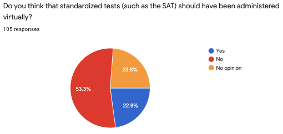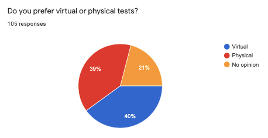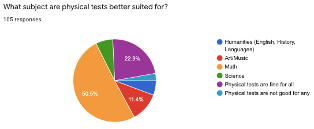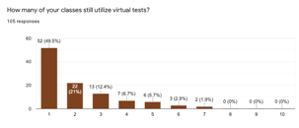Assessments: Physical vs. Virtual

November 3, 2021
Testing is ingrained in BCA’s culture: to even be accepted into BCA, one must pass an entrance test. From then on, a BCA student would typically handle regular assessments for courses as well as national assessments such as the PSAT and AP exams that all culminate in college acceptance.
However, the Covid pandemic has changed the nation’s testing culture: standardized tests were halted for a year, more and more colleges have become test-optional, and even regular exams were conducted in a new, virtual setting. Now that BCA has re-opened, BCA students have a unique perspective, having experienced both physical tests and virtual tests.
105 randomly-polled BCA students recalled various testing platforms used. They reported that teachers used websites such as Edulastic, Schoology, Cengage, WebAssign, Google Classroom, and Microsoft Teams.
46.7% (49) of students reported Google Classroom as their favorite test-taking platform, and the majority favored using the survey tool Google Forms.
“I liked Google Forms best because it was the clearest,” one student stated. “I’m already used to taking surveys on Google Forms, so I wasn’t worried about the program malfunctioning. Also, I liked that I could see all the questions at once. While some teachers had different sections for questions, there was no way to disable going back, so I could always return to previous sections to check my answers. Finally, it was really easy to upload PDFs to submit my scrap work.”
Schoology was the second most popular platform, with 36.2% (38) preferring it. Schoology’s main benefit, like Google Classroom’s, was its familiarity to students.
“Especially during virtual school, all of my teachers were using Schoology a lot more,” one student said. “It was much easier to have all my tests in one spot, in Schoology.”
However, students generally complained that Schoology tended to crash when too many students tried to use it at once, which was a problem when the whole class had to take a test together.
Other programs such as Edulastic, WebAssign, and Cengage were in the minority of preferences, with most students saying that they didn’t have an opinion on either program.
A few students recalled that their particularly creative teachers would, “Post a test document online and have us print it out, write directly on it, and scan it and submit it as a PDF.” In an unprecedented time, having some sense of a normal test, albeit with extra steps required to submit, was extremely reassuring to students.

The past few years have given students enough experience with physical and virtual tests for them to form standard opinions: interestingly enough, the number of students who favor virtual tests and the number who favor physical tests is close to
even. 40% (41) reported preferring virtual tests while 39% (41) preferred physical, while 21% (22) had no opinion.
Their reported performance on different types of tests, however, had a clearer divide: again, 40% (42) reported performing better on virtual tests, but just 18.1% (19) reported a better performance on physical tests. 35.2% (37) stated that their performance was not affected either way, and 6.7% (7) did not have an opinion.
“I like physical tests more,” one student stated. “It’s easier to focus in a classroom where everybody’s silent and a teacher’s monitoring us. I didn’t have that virtually: I was on a Zoom with other people in my house making noise.”
It would seem that, therefore, she would be more confident in her performance in physical tests, but she reported a benefit of virtual tests: “Most of my teachers either made our virtual tests easier to fit into the shorter Zoom periods or just let us use our notes. I’m still getting used to memorizing information.”
Not all tests are created equal: on top of type, environment, and platform used to administer a test, students did report that the subject being assessed impacted how well it fared physically vs. virtually.
 When asked what subjects did best in a virtual setting, the vast majority, 50.5% (53) reported that Humanities such as English, History, and Foreign Languages worked best virtually. After that, 24.8% (28) stated that virtual tests were fine regardless of the subject. 10.5% (11) believed that virtual Math tests were the best, followed by 7.6% (8) preferring Science subjects, 3.8% (4) stating that no subject was suited for virtual assessments, and just 2.9% (3) believing that Art and Music worked best virtually.
When asked what subjects did best in a virtual setting, the vast majority, 50.5% (53) reported that Humanities such as English, History, and Foreign Languages worked best virtually. After that, 24.8% (28) stated that virtual tests were fine regardless of the subject. 10.5% (11) believed that virtual Math tests were the best, followed by 7.6% (8) preferring Science subjects, 3.8% (4) stating that no subject was suited for virtual assessments, and just 2.9% (3) believing that Art and Music worked best virtually.
 When asked what subjects do best in a physical setting, the divide was still present: 50.5% (53) reported that Math was best when assessed physically, followed by 22.9% (24) stating that physical tests worked fine for all subjects, 11.4% (12) stating that Art and Music were best assessed physically, 6.7% (7) preferring physical Science tests, 5.7% (6) preferring physical Humanities tests, and just 2.9% (3) stating that physical tests did not work well for any subject.
When asked what subjects do best in a physical setting, the divide was still present: 50.5% (53) reported that Math was best when assessed physically, followed by 22.9% (24) stating that physical tests worked fine for all subjects, 11.4% (12) stating that Art and Music were best assessed physically, 6.7% (7) preferring physical Science tests, 5.7% (6) preferring physical Humanities tests, and just 2.9% (3) stating that physical tests did not work well for any subject.
“For subjects where there’s a lot of writing, like Languages, English, and History, virtual tests worked really well, because most students can type faster than they can handwrite,” one student summarized. “However, it’s harder to do calculations on a computer, and you kind of need to do them on paper. So, subjects with a lot of math in them work better physically, because it’s much easier to submit work in person.”
 It appears that most teachers were eager to leave the days of Zoom school behind them: the majority of students reported that very few of their classes still administer tests virtually, with nearly 90% (94) of students saying that they still take virtual assessments in four or less of their classes and over 70% (73) saying that they take virtual assessments in two or less of their core classes.
It appears that most teachers were eager to leave the days of Zoom school behind them: the majority of students reported that very few of their classes still administer tests virtually, with nearly 90% (94) of students saying that they still take virtual assessments in four or less of their classes and over 70% (73) saying that they take virtual assessments in two or less of their core classes.
One student wanted to cleanse her life of virtual tests. “I don’t know why anybody would want to keep giving virtual tests,” she complained. “The computer gives us all headaches, and there’s no need now that we’re back in the same building.”
However, another mentioned that virtual tests can be quite practical for both essays and tests: “I think that it would be a lot easier to leave feedback on online essays, because you won’t run out of space when writing in the margins. Also, it seems a lot easier to grade virtual multiple-choice tests—the only other type of easy automatic grading is a Scantron, which would be even more of a hassle for students then just taking the test online.”
In all the hustle of a busy BCA schedule, especially after a year heavily impacted by Covid, it’s easy for students to forget standardized testing, and this past month’s PSAT and Start Strong assessments have been an awakening from last year’s break.
 However, the test-free time has not appeared to significantly hinder students’ moral.
However, the test-free time has not appeared to significantly hinder students’ moral.
When given a scale from one to five with a five being “Completely Confident” and a one being “Not Confident,” and asked to rank how confident they felt in the recent standardized tests despite the virtual break, 40% (42) ranked themselves at a four, meaning very confident. 28.6% (30) were moderately confidently, 18.1% (19) somewhat confident, 8.6% (9) completely confident, and 4.8% (5) not confident at all.
 This confidence likely contributed to the overall student opinion that, though missing standardized tests last year has made taking them this year a re-adjustment, it would not have been a good idea to take virtual standardized tests.
This confidence likely contributed to the overall student opinion that, though missing standardized tests last year has made taking them this year a re-adjustment, it would not have been a good idea to take virtual standardized tests.
53.3% (56) agreed that standardized tests should not be virtually administered, with 23.8% (25) having no opinion and 22.9% (24) thinking that they should have been virtually proctored.
“It would have been too hard to monitor virtual standardized tests,” one student said. “We could all have been watched on a Zoom, but somebody would still find a way to cheat. It seems much less secure.”
However, another said, “It would have been nice if more practice tests could have been nationally administered, even virtually. If the PSAT doesn’t count in 10th Grade, the current Juniors still could have taken it, just so that they could have an idea of their performance instead of taking the real one blindly.”
One student actually appreciated the absence of assessments: “Spending a year without standardized tests means that more colleges are willing to be test-optional, which is really good for students who don’t like taking tests or may have done poorly. I think that reducing the impact that standardized tests have on a college application also reduces stress and allows us to focus on our classes and activities that we’re passionate about.”
Tests are a hallmark of school that likely won’t completely disappear, but the transitions between virtual and physical school have given BCA students diverse experiences regarding various styles of assessments. BCA students and staff have acquired the perseverance and flexibility necessary to thrive in such instability, and, ultimately, will be prepared no matter what type of assessments will be present in the future.




